2003 CADILLAC SEVILLE warning light
[x] Cancel search: warning lightPage 238 of 408
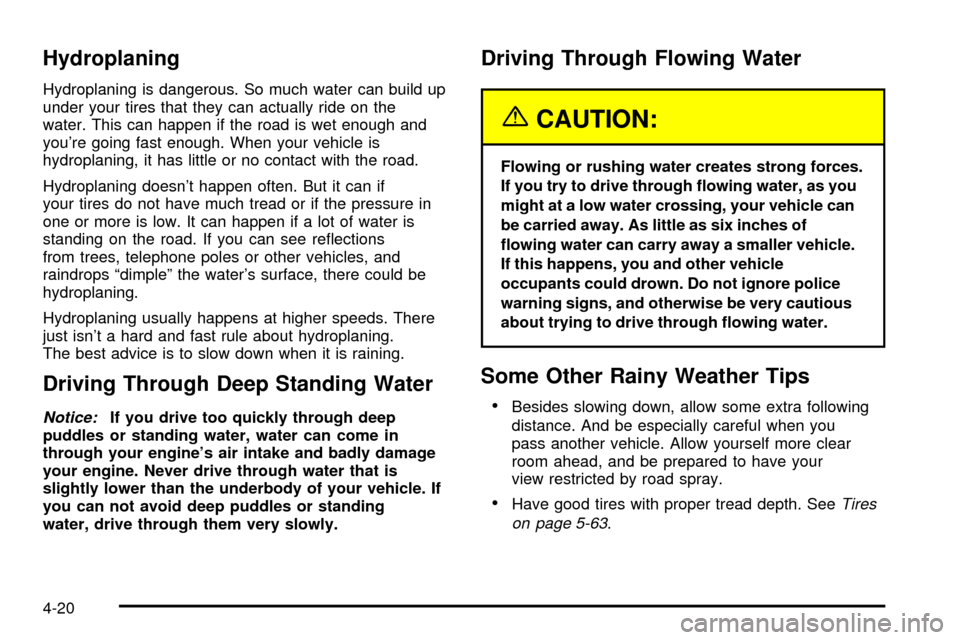
Hydroplaning
Hydroplaning is dangerous. So much water can build up
under your tires that they can actually ride on the
water. This can happen if the road is wet enough and
you're going fast enough. When your vehicle is
hydroplaning, it has little or no contact with the road.
Hydroplaning doesn't happen often. But it can if
your tires do not have much tread or if the pressure in
one or more is low. It can happen if a lot of water is
standing on the road. If you can see re¯ections
from trees, telephone poles or other vehicles, and
raindrops ªdimpleº the water's surface, there could be
hydroplaning.
Hydroplaning usually happens at higher speeds. There
just isn't a hard and fast rule about hydroplaning.
The best advice is to slow down when it is raining.
Driving Through Deep Standing Water
Notice:If you drive too quickly through deep
puddles or standing water, water can come in
through your engine's air intake and badly damage
your engine. Never drive through water that is
slightly lower than the underbody of your vehicle. If
you can not avoid deep puddles or standing
water, drive through them very slowly.
Driving Through Flowing Water
{CAUTION:
Flowing or rushing water creates strong forces.
If you try to drive through ¯owing water, as you
might at a low water crossing, your vehicle can
be carried away. As little as six inches of
¯owing water can carry away a smaller vehicle.
If this happens, you and other vehicle
occupants could drown. Do not ignore police
warning signs, and otherwise be very cautious
about trying to drive through ¯owing water.
Some Other Rainy Weather Tips
·Besides slowing down, allow some extra following
distance. And be especially careful when you
pass another vehicle. Allow yourself more clear
room ahead, and be prepared to have your
view restricted by road spray.
·Have good tires with proper tread depth. SeeTires
on page 5-63
.
4-20
Page 239 of 408
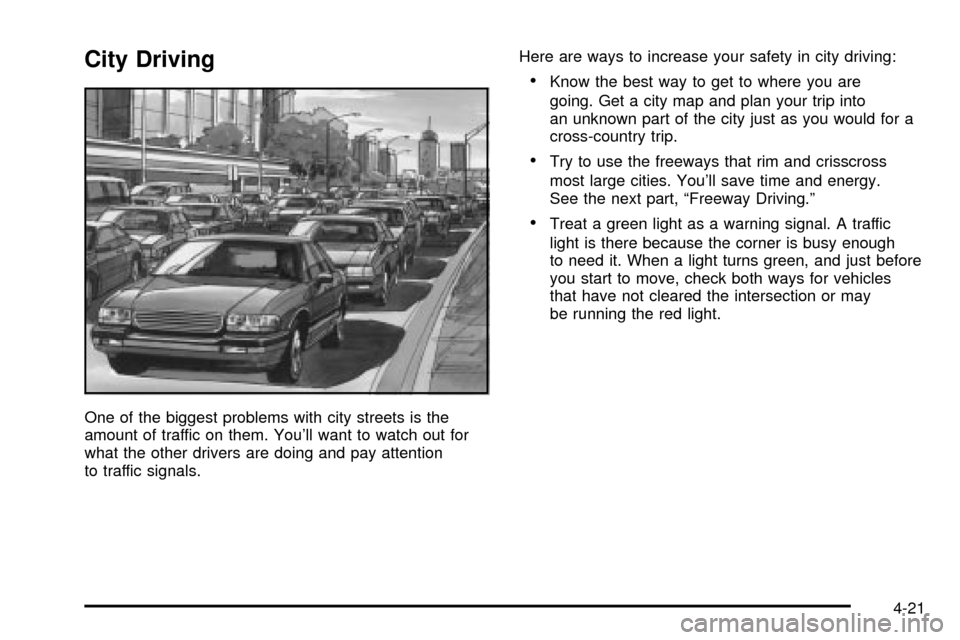
City Driving
One of the biggest problems with city streets is the
amount of traffic on them. You'll want to watch out for
what the other drivers are doing and pay attention
to traffic signals.Here are ways to increase your safety in city driving:
·Know the best way to get to where you are
going. Get a city map and plan your trip into
an unknown part of the city just as you would for a
cross-country trip.
·Try to use the freeways that rim and crisscross
most large cities. You'll save time and energy.
See the next part, ªFreeway Driving.º
·Treat a green light as a warning signal. A traffic
light is there because the corner is busy enough
to need it. When a light turns green, and just before
you start to move, check both ways for vehicles
that have not cleared the intersection or may
be running the red light.
4-21
Page 244 of 408
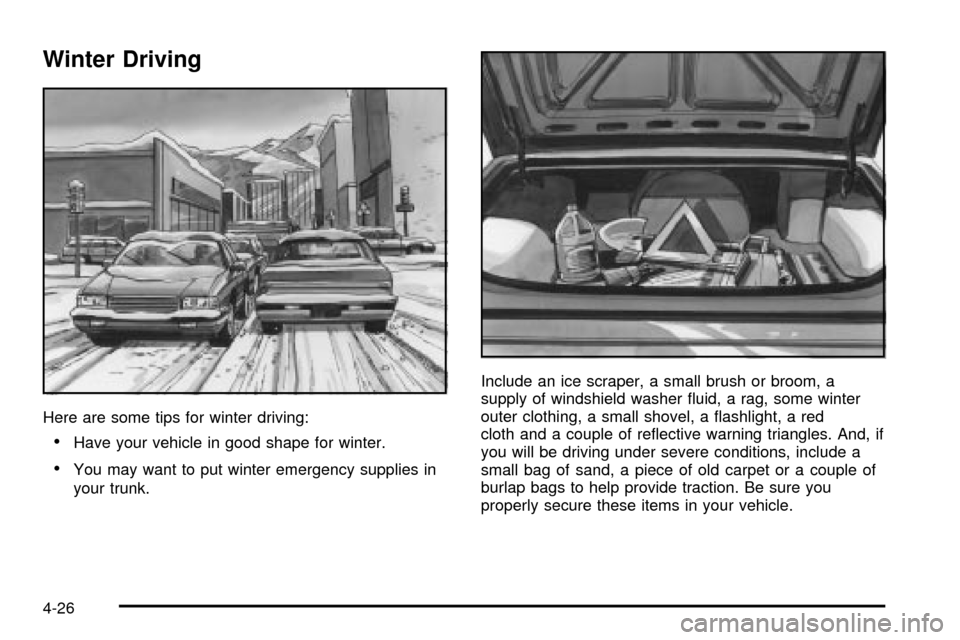
Winter Driving
Here are some tips for winter driving:
·Have your vehicle in good shape for winter.
·You may want to put winter emergency supplies in
your trunk.Include an ice scraper, a small brush or broom, a
supply of windshield washer ¯uid, a rag, some winter
outer clothing, a small shovel, a ¯ashlight, a red
cloth and a couple of re¯ective warning triangles. And, if
you will be driving under severe conditions, include a
small bag of sand, a piece of old carpet or a couple of
burlap bags to help provide traction. Be sure you
properly secure these items in your vehicle.
4-26
Page 285 of 408

Engine Coolant
The cooling system in your vehicle is ®lled with
DEX-COOLžengine coolant. This coolant is designed
to remain in your vehicle for 5 years or 150,000 miles
(240 000 km), whichever occurs ®rst, if you add
only DEX-COOL
žextended life coolant.
The following explains your cooling system and how to
add coolant when it is low. If you have a problem
with engine overheating, see
Engine Overheating on
page 5-28.
A 50/50 mixture of clean, drinkable water and
DEX-COOL
žcoolant will:
·Give freezing protection down to-34É F (-37É C).
·Give boiling protection up to 265É F (129É C).
·Protect against rust and corrosion.
·Help keep the proper engine temperature.
·Let the warning lights and gages work as they
should.
Notice:When adding coolant, it is important that
you use only DEX-COOLž(silicate-free) coolant.
If coolant other than DEX-COOLžis added to
the system, premature engine, heater core or
radiator corrosion may result. In addition, the engine
coolant will require change sooner -- at 30,000 miles
(50,000 km) or 24 months, whichever occurs ®rst.
Damage caused by the use of coolant other
than DEX-COOL
žis not covered by your new vehicle
warranty.
5-25
Page 288 of 408
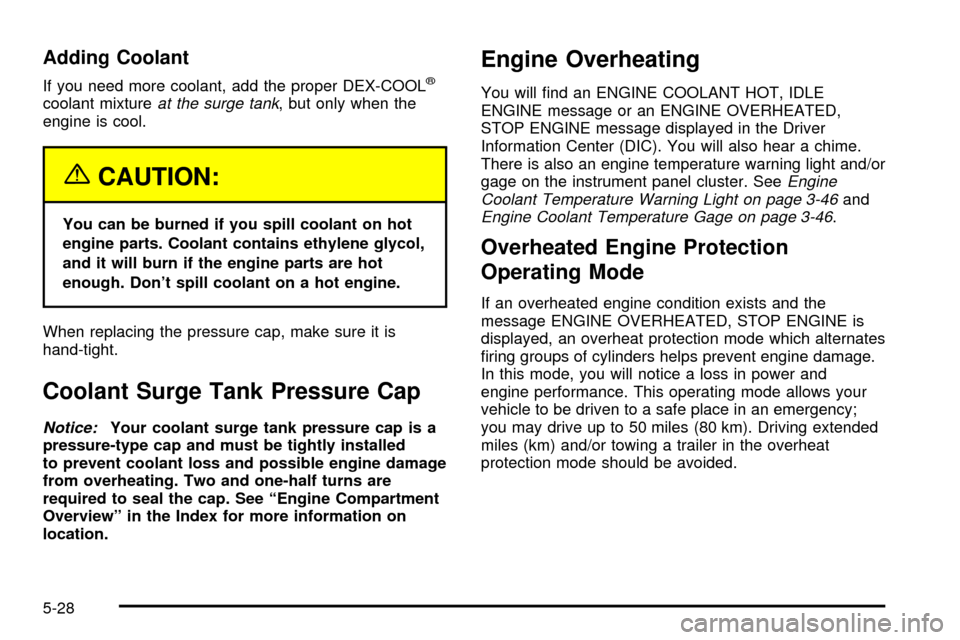
Adding Coolant
If you need more coolant, add the proper DEX-COOLž
coolant mixtureat the surge tank, but only when the
engine is cool.
{CAUTION:
You can be burned if you spill coolant on hot
engine parts. Coolant contains ethylene glycol,
and it will burn if the engine parts are hot
enough. Don't spill coolant on a hot engine.
When replacing the pressure cap, make sure it is
hand-tight.
Coolant Surge Tank Pressure Cap
Notice:Your coolant surge tank pressure cap is a
pressure-type cap and must be tightly installed
to prevent coolant loss and possible engine damage
from overheating. Two and one-half turns are
required to seal the cap. See ªEngine Compartment
Overviewº in the Index for more information on
location.
Engine Overheating
You will ®nd an ENGINE COOLANT HOT, IDLE
ENGINE message or an ENGINE OVERHEATED,
STOP ENGINE message displayed in the Driver
Information Center (DIC). You will also hear a chime.
There is also an engine temperature warning light and/or
gage on the instrument panel cluster. See
Engine
Coolant Temperature Warning Light on page 3-46andEngine Coolant Temperature Gage on page 3-46.
Overheated Engine Protection
Operating Mode
If an overheated engine condition exists and the
message ENGINE OVERHEATED, STOP ENGINE is
displayed, an overheat protection mode which alternates
®ring groups of cylinders helps prevent engine damage.
In this mode, you will notice a loss in power and
engine performance. This operating mode allows your
vehicle to be driven to a safe place in an emergency;
you may drive up to 50 miles (80 km). Driving extended
miles (km) and/or towing a trailer in the overheat
protection mode should be avoided.
5-28
Page 302 of 408
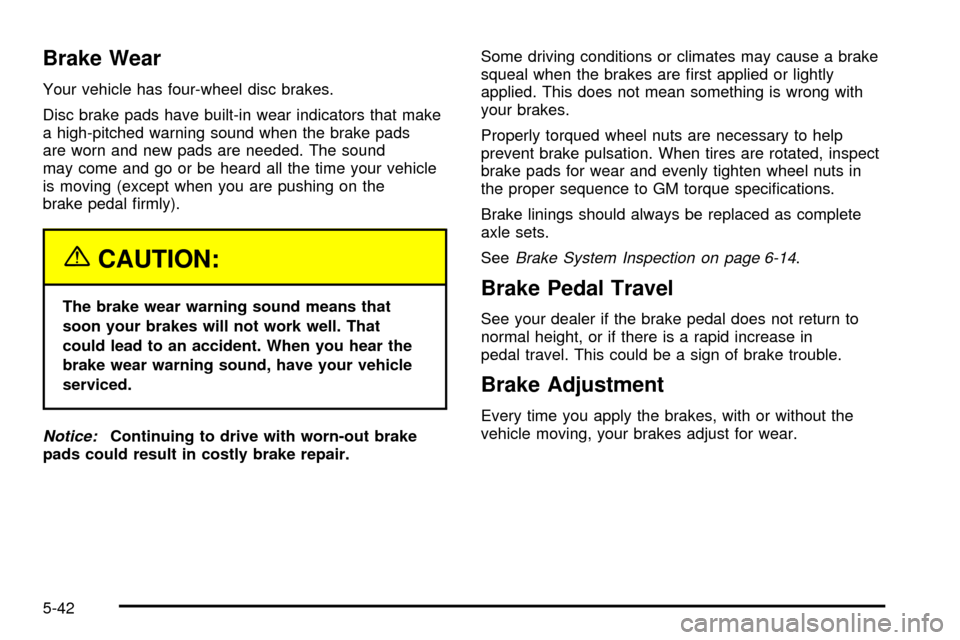
Brake Wear
Your vehicle has four-wheel disc brakes.
Disc brake pads have built-in wear indicators that make
a high-pitched warning sound when the brake pads
are worn and new pads are needed. The sound
may come and go or be heard all the time your vehicle
is moving (except when you are pushing on the
brake pedal ®rmly).
{CAUTION:
The brake wear warning sound means that
soon your brakes will not work well. That
could lead to an accident. When you hear the
brake wear warning sound, have your vehicle
serviced.
Notice:Continuing to drive with worn-out brake
pads could result in costly brake repair.Some driving conditions or climates may cause a brake
squeal when the brakes are ®rst applied or lightly
applied. This does not mean something is wrong with
your brakes.
Properly torqued wheel nuts are necessary to help
prevent brake pulsation. When tires are rotated, inspect
brake pads for wear and evenly tighten wheel nuts in
the proper sequence to GM torque speci®cations.
Brake linings should always be replaced as complete
axle sets.
See
Brake System Inspection on page 6-14.
Brake Pedal Travel
See your dealer if the brake pedal does not return to
normal height, or if there is a rapid increase in
pedal travel. This could be a sign of brake trouble.
Brake Adjustment
Every time you apply the brakes, with or without the
vehicle moving, your brakes adjust for wear.
5-42
Page 393 of 408

A
Accessory Power Outlets.................................3-26
Adding Washer Fluid.......................................5-39
Additional Program Information........................... 7-9
Additives, Fuel................................................. 5-6
Add-On Electrical Equipment............................5-92
Adjusting the Speakers (Balance/Fade)......3-81, 3-90
Air Bag System, Supplemental In¯atable
Restraint (SIR)............................................1-44
Air Bag .........................................................3-42
Readiness Light..........................................3-42
Air Cleaner/Filter, Engine.................................5-19
AM .............................................................3-103
Antenna, Diversity Antenna System..................3-106
Antenna, XMŸ Satellite Radio
Antenna System........................................3-106
Anti-lock Brake System (ABS)............................ 4-7
Anti-Lock Brake, System Warning Light..............3-44
Anti-Pinch Feature..........................................2-17
Appearance Care............................................5-83
Care of Safety Belts....................................5-86
Chemical Paint Spotting...............................5-89
Cleaning the Inside of Your Vehicle................5-84
Cleaning the Outside of Your Vehicle..............5-86
Finish Damage............................................5-89
Sheet Metal Damage...................................5-88
Underbody Maintenance...............................5-89Appearance Care (cont.)
Vehicle Care/Appearance Materials................5-90
Weatherstrips..............................................5-86
Ashtrays........................................................3-27
Assist Handles...............................................2-49
Audio System(s).............................................3-78
Audio Steering Wheel Controls....................3-103
Care of Your Cassette Tape Player...............3-104
Care of Your CD Player..............................3-105
Care of Your CDs......................................3-105
Console-Mounted CD Changer......................3-99
Diversity Antenna System............................3-106
Navigation/Radio System..............................3-98
Radio Personalization with Home and
Away Feature........................................3-102
Radio with Cassette and CD.................3-79, 3-87
Setting the Time for Radios with Radio
Data Systems (RDS)................................3-78
Setting the Time for Radios without
Radio Data Systems (RDS).......................3-78
Theft-Deterrent Feature...............................3-102
Understanding Radio Reception...................3-103
XMŸ Satellite Radio Antenna System...........3-106
Auto Exit Seat................................................3-66
Auto Exit Steering Wheel.................................3-67
Automatic Level Control...................................4-34
Automatic Transaxle Check..............................6-10
Automatic Transaxle Shift Lock Control
System Check.............................................6-11
1
Page 394 of 408

Automatic Transaxle........................................5-21
Fluid..........................................................5-21
Operation...................................................2-28
B
Backing Up....................................................4-40
Battery Load Management...............................3-23
Battery Replacement......................................... 2-8
Battery..........................................................5-43
Before Leaving on a Long Trip.........................4-23
Body Lubrication Service..................................6-10
Brake Adjustment............................................5-42
Brake Fluid....................................................5-40
Brake Pedal Travel.........................................5-42
Brake Wear...................................................5-42
Brake............................................................2-31
Parking......................................................2-31
System Inspection.......................................6-14
System Warning and Parking Brake
Indicator Light..........................................3-43
Brakes..........................................................5-40
Braking in Emergencies..................................... 4-9
Braking........................................................... 4-6
Break-In, New Vehicle.....................................2-23
Bulb Replacement...........................................5-55
Center High-Mounted Stoplamp (CHMSL)........5-60
Front Turn Signal Lamps..............................5-59
Halogen Bulbs............................................5-56Bulb Replacement (cont.)
Headlamp Aiming........................................5-51
Headlamps.................................................5-56
High Intensity Discharge (HID) Lighting...........5-55
Replacement Bulbs......................................5-61
Taillamps and Turn Signal Lamps..................5-60
Buying New Tires...........................................5-68
C
Cadillac Owner PrivilegesŸ............................... 7-6
California Fuel.................................................. 5-5
Canada ± Customer Assistance.......................... 7-4
Canadian Owners................................................ ii
Capacities and Speci®cations..........................5-100
Carbon Monoxide...................4-26, 4-35, 2-12, 2-35
Care of.........................................................5-86
Safety Belts................................................5-86
Your Cassette Tape Player..........................3-104
Your CD Player.........................................3-105
Your CDs .................................................3-105
Cassette Tape Messages.........................3-85, 3-96
Cassette Tape Player Service............................. 6-9
CD Changer, Console-Mounted.........................3-99
Cellular Phone Usage....................................3-104
Cellular Telephone, Storage Area......................2-48
Center Console Storage Area...........................2-49
Center High-Mounted Stoplamp (CHMSL)...........5-60
Chains, Tires..................................................5-72
2